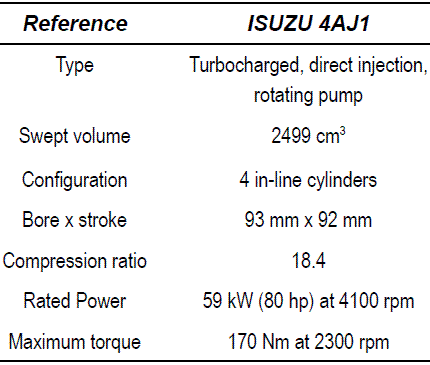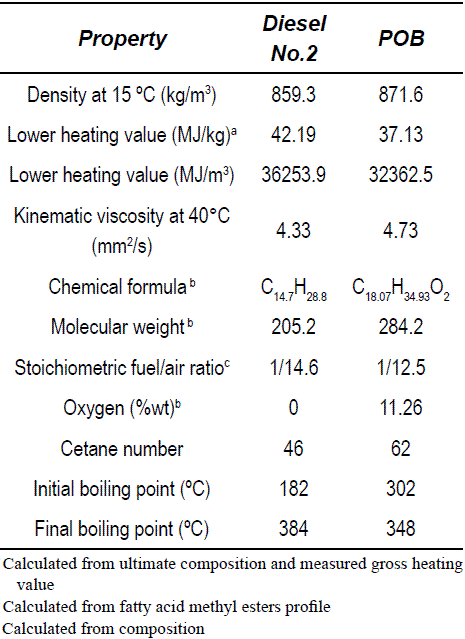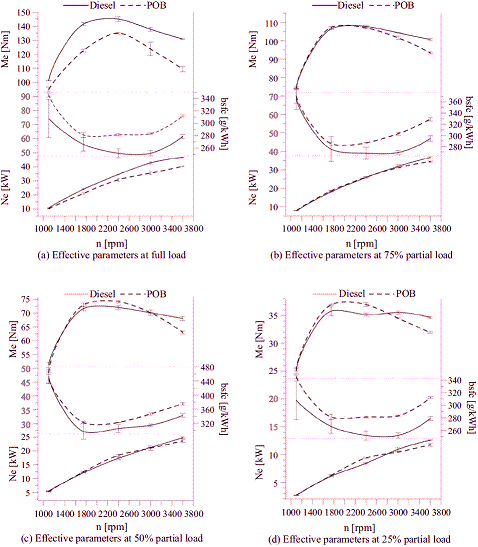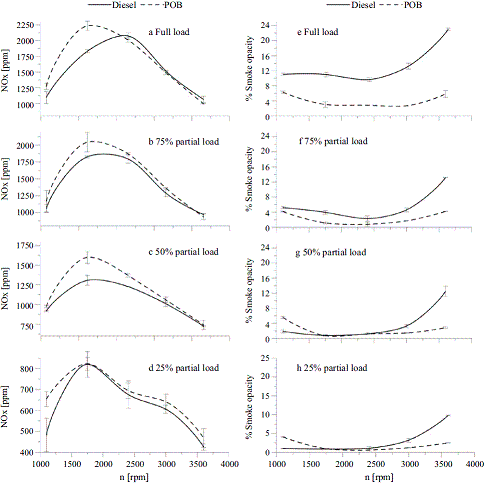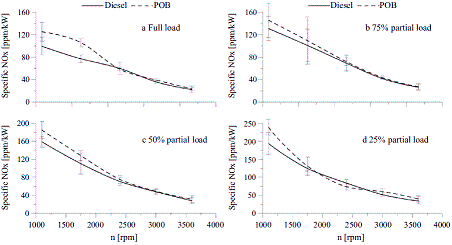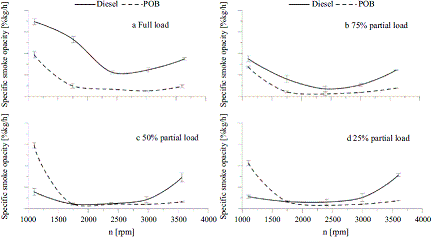Serviços Personalizados
Journal
Artigo
Indicadores
-
 Citado por SciELO
Citado por SciELO -
 Acessos
Acessos
Links relacionados
-
 Citado por Google
Citado por Google -
 Similares em
SciELO
Similares em
SciELO -
 Similares em Google
Similares em Google
Compartilhar
Revista Facultad de Ingeniería Universidad de Antioquia
versão impressa ISSN 0120-6230versão On-line ISSN 2422-2844
Rev.fac.ing.univ. Antioquia n.51 Medellín jan./mar. 2010
Evaluation of nitrogen oxide emissions and smoke opacity in a HSDI diesel engine fuelled with palm oil biodiesel
Evaluación de las emisiones de óxidos de nitrógeno y la opacidad de humos en un motor diesel operando con biodiesel de aceite de palma puro
John Agudelo1, Pedro Benjumea2, Adriana Patricia Villegas1
1Group of Efficient Energy Management -GIMEL- Engineering Faculty, Universidad de Antioquia, Apartado Aéreo 1226, Medellín, Colombia
2Alternative Fuels Group, Energy Institute, Faculty of Mines, Universidad Nacional de Colombia Sede Medellín, Cra 80 No 65-223, Medellín, Colombia
Abstract
In this paper, an experimental study evaluating engine performance, nitrogen oxide emissions (NOx) and smoke opacity of a HSDI (high speed direct injection) diesel engine fuelled with neat palm oil biodiesel (POB) is presented. Tests were performed in a bench-mounted automotive diesel engine operating under steady state conditions. Conventional diesel fuel was taken as base line or reference fuel. Results show that at full-load operation POB led to a power output decrease between 10% and 17% and an effective specific fuel consumption increase between 14% and 22%. At full-load and low engine speeds an increase of 20% in NOx emissions was measured. However, at the same torque rating and high engine speeds a 6% decrease in such emissions was obtained. At partial-load, NOx emissions always increased using POB, this effect being more pronounced at low speeds. On the other hand, smoke opacity significantly decreased (between 40% and 80%) regardless of engine load. According to the experimental results POB fuelling reduced engine power output, increased fuel consumption, increased slightly efficiency, always decreased smoke opacity, and reduced or increased NOx emissions depending on the engine operation mode.
Keywords: palm oil biodiesel, NOx emissions, smoke opacity, diesel engines
Resumen
En este artículo se presenta un estudio experimental evaluando las prestaciones mecánicas, las emisiones de óxidos de nitrógeno (NOx) y la opacidad de humos de un motor diesel de alta velocidad e inyección directa operando con biodiesel de palma puro. Las pruebas se llevaron a cabo en un motor de automoción montado en un banco de ensayos y operando bajo condiciones estacionarias. Como línea base o combustible de referencia se tomó combustible diesel convencional. Los resultados indican que la utilización del biodiesel de palma, operando el motor a condiciones de plena carga, condujo a una disminución de potencia entre 10% y 17% y a un aumento en el consumo de combustible entre 14% y 22%. A plena carga y bajos regímenes de giro se midió un incremento en los óxidos de nitrógeno en torno a 20%. Sin embargo, bajo las mismas condiciones de carga y altas velocidades del motor se obtuvo una disminución del 6%. A carga parcial siempre se obtuvieron incrementos en las emisiones de NOx al usar biodiesel de palma, siendo más pronunciado el efecto a bajo régimen de giro. Por su parte, la opacidad de humos disminuyó significativamente (entre 40% y 80%) independiente del grado de carga. De acuerdo con los resultados experimentales, el uso del biodiesel de aceite puro de palma disminuyó la potencia entregada por el motor, aumentó el consumo de combustible, incrementó ligeramente la eficiencia, disminuyó siempre la opacidad de humos, y disminuyó o aumentó las emisiones de óxidos de nitrógeno dependiendo del modo de operación del motor.
Palabras clave: biodiesel de aceite de palma, emisiones de NOx, opacidad de humos, motores diesel
Introduction
The global market for biodiesel has undergone a fast growth during last years. Worldwide production of this biofuel has increased from 2.2 MT (million tons) in 2002, to 3.6 MT in 2005 and 9 MT in 2007 [1]. Although most part of the installed biodiesel production capacity is settled in the European Union and United States, for the next years it is expected a significant growth of this industry in Asian and Latin American countries. Biodiesel use has been driven by the widely diagnosed troubles associated with fossil fuels: reserves depletion, environment negative impacts, prices volatility; and especially for its intrinsic characteristics as a biofuel: renewable, sulfur and aromatic-hydrocarbons free, less toxic and more biodegradable.
In general terms, biodiesel properties are comparable with those of conventional diesel fuels and therefore it can be used neat or blended in existing diesel engines without carrying out significant engine adjustments. However, differences in fuels chemical nature lead to differences in their basic properties affecting engine performance, combustion process and pollutant emissions [2].
In parallel to the development of its industry, several pieces of research have been carried out in order to evaluate the effect of biodiesel fuelling on engine performance and emissions, taking conventional diesel fuel as a reference fuel or base line [3-10]. Although from such studies, most of them of experimental type, it is possible to draw some tendencies, it is necessary to bear in mind that their results, especially those related with emissions quantification, can not be generalized. When the level of emissions from different fuels is compared, it must be taken into account that its magnitude depends on a wide variety of factors such as: type and technology of the engine and its fuel injection system, ambient conditions, measurement technique for the considered pollutant species, reference fuel quality, biodiesel nature and quality, and so on [10].
There is a broad consensus in that biodiesel fuelling leads to significant reductions in particulate matter, total hydrocarbons and carbon monoxide emissions [5, 8, 10, 11]. Also, most authors report decreases in aromatic and polyaromatic hydrocarbon emissions [7, 9, 12]. In the case of nitrogen oxides, a slight increase in their emissions is the most common observation in research literature [10, 13-16].
Smoke opacity is an indirect indicator of soot content in the exhaust gases. Therefore this parameter can be correlated with the fuel’s tendency to form particulate matter (PM) during engine operation. The majority of studies agree that the reduction in PM emissions is due to a notable decrease in the concentration of its insoluble fraction (mainly soot) as a consequence of the oxygen presence and aromatic hydrocarbons absence in biodiesel fuels [7, 10, 17-19]. The oxygen content of the ester molecule allows, with the same air at the admission, a more complete combustion, even in zones of the combustion chamber with fuel rich diffusion flames; and additionally promotes the oxidation of the already formed soot. The lack of aromatic hydrocarbons in biodiesel implies a reduction in the concentration of soot precursor species in the combustion chamber [19].
According to the Zeldovich mechanism, the formation and destruction of nitric oxide (NO) is favored by higher local temperatures and oxygen availability in the flame zone [20]. Several researchers have reported advances in the combustion process as a consequence of injection advances derived from the physical properties of biodiesel, mainly its lower compressibility and higher speed of sound [21-24]. A more advanced start of combustion leads to higher mean temperature peaks inside the combustion chamber. Other researchers have associated the higher flame temperatures obtained with biodiesel with an increase in the adiabatic flame temperature and a reduction in the heat dissipation by radiation, as a consequence of the lower amount of soot emitted [15, 19]. Regarding oxygen availability there are contradictory positions. Song et al. [24] showed that both the intake oxygen enrichment and the use of oxygenated fuels increase NOx emissions. This increase was higher when oxygen enrichment was used rather than when using oxygenated fuels. Lapuerta et al. [17] concluded that the oxygen content of biodiesel could not cause any increase in NO formation because diffusion combustion occurs mainly in regions with oxygen-fuel ratio around the stoichiometric one, which is 2.81 for typical biodiesel fuels and 3.58 for a standard diesel fuel. The internal oxygen in the fuel molecule being not enough to compensate such a difference. The main objective of this work is to evaluate the nitrogen oxide emissions and the smoke opacity of a HSDI diesel engine fuelled with neat palm oil biodiesel taking conventional diesel fuel as base line.
Methodology
Tests were carried out in a bench-mounted and instrumented automotive diesel engine (Table 1).
Table 1 Engine specifications
In order to characterize and monitor accurately the engine’s operating mode the test bench was equipped with sensors and thermocouples for mean temperature and pressure measurements. Effective torque and engine speed were measured and controlled by a Go Power D512 hydraulic dynamometric brake. Air and fuel consumptions were measured by a hot-wire sensor (Magnetrol TA2) and a Danfoss Coriolis-acceleration type mass-flow meter, respectively. NOx emissions were quantified by a Horiba EXA 240CL chemiluminescense analyzer. Smoke opacity was measured by an AVL DICOM 400 optical opacimeter. Data related to engine operation variables, instantaneous in-cylinder pressure, injection pressure and crankshaft angle were collected using an in-house developed software called ARAMÉ.
Tests were performed using neat palm oil biodiesel (POB) purchased from ODIN Energy Santa Marta S.A. and commercial grade No. 2 diesel fuel purchased from a local fuel station (Table 2). For each fuel, twenty operation modes, each one characterized by a certain effective torque and engine speed, were tested. The operation modes selected try to simulate representative engine conditions covering the whole load range (25%, 50%, 75% and 100% of maximum torque) at various speeds (Table 3). Four set of measurements (80 tests) were carried out with the reference fuel, while three set of measurements (60 tests) were performed with POB. The results presented correspond to average values, taking into account their standard deviations.
Torque values corresponding to full-load condition were measured for both fuels. In the case of partial loads, torque values were calculated from the full-load torque of the reference fuel. A meaningful comparison of emissions and fuel consumption is only possible if tests for both fuels are carried out under the same operation mode. Measurements were carried out under steady state conditions, which were indicated by the exhaust gas temperature. After each fuel was tested, fuel lines were drained prior to filling them with the next one. Then the engine was operated at least one hour on the new fuel to purge any of the remaining non-test fuel from the engine fuelling system.
Table 2 Fuel properties
Table 3 Engine operation modes
Results and discussion
As can be seen in figure 1a, only at full-load the power output (Ne) delivered with POB was reduced with respect to that delivered with diesel fuel. This result was in agreement with the established methodology since the torque values at that load condition were functions of the fuel tested. However, the decrease in rated power (between 5% and 10%) was lower than the reduction in heating value in volume basis (close to 11%, see table 2) indicating that POB fuelling led to some power recovery or increase in thermal efficiency. From figure 1a, it can also be inferred that at full-load, POB fuelling led to a decrease in the effective torque (Me) between 10% and 17% and an increase in the specific fuel consumption (bsfc) between 14% and 22%, depending on engine speed (n).
At partial-loads (figures 1b, 1c y 1d), the experimental goal was to attain the same engine speed and torque, regardless the fuel used. Under these conditions, the specific fuel consumption, the ratio between mass fuel consumption and brake effective power, when using POB increased between 5% and 22% (an average of 13.5%) in relation to the consumption of diesel fuel, indicating that the loss of heating value in mass basis (around 12%, see table 2) must be compensated with higher fuel consumption.
As can be seen in figures 2a to 2d, for both fuels and at all engine speeds, NOx emissions were a direct function of engine loading. This was expected because with increasing load, the temperature of the combustion chamber increases and NOx formation is a strongly temperature dependent phenomenon. Figures 2a to 2d also show that for both fuels and at all loads NOx emissions initially increased reaching a maximum close to 1750 rpm, and then decreased as the engine speed was increased. This behavior has been related with the nonlinear nature of the chemical rates variation with temperature [25]. It is important to bear in mind that NOx formation and destruction is a kinetic-controlled process. At high speeds (higher than 1750 rpm) NOx emissions decreased for both fuels at all loads as a consequence of shorter residence times of gases in the combustion chamber. At full-load the effect of POB fuelling in NOx emissions was dependent on engine speed (figure 2a). At low engine speeds (lower than that corresponding to maximum torque) NOx emissions with POB were higher (up to 30%) than those measured with diesel fuel. At faster engine speeds NOx emissions were slightly higher with diesel fuel. At the lower load percentage (figure 2d), the lowest NOx emissions were obtained and there was not much difference between both fuels across the speed range.
The effect of fuel properties on NOx emissions can be related to their effect on two parameters promoting high temperatures in the cylinder and thus NOx emissions. These are combustion timing and combustion rate [22]. Combustion timing in a diesel engine is mainly affected by the start of injection. POB has lower energy content than diesel fuel and when a greater volume of fuel is injected to correct for this, some rotary fuel injection pumps (the type used on the tested engine) can advance the start of injection timing, advancing the start of combustion and so increasing NOx emissions. POB also has different physical properties such as higher density, and viscosity, which also lead to an earlier start of injection. On the other hand, a high cetane number reduces the combustion rate and so NOx emissions. POB’s high cetane number (table 2) is expected to shorten the ignition delay period and thus decreases the amount of fuel that is involved in the premixed phase of combustion which is associated with higher temperature gradients.
Analyzing the combined effect of BOP fuelling and engine operation mode, it can be inferred that the potential of fuel’s cetane number to decrease NOx emissions is diminish at the existing conditions in the combustion chamber at higher loads and slower velocities. From figure 3, it can be inferred that specific NOx emissions (per unit power output) decreased with increasing speed (regardless the load) and with increasing load. Regarding fuel type, at low speeds specific NOx emissions were higher with POB at all loads. However, at all loads there was little difference in such specific emissions between both fuels from 2400 rpm onwards. These results show that in the range of loads and engine speeds in which the engine is most likely to operate, the specific NOx emissions with POB fuelling are comparable with those of diesel fuelling.
Figure 1 Effective parameters (torque, power and specific fuel consumption) versus engine speed at full-load and partial-loads for POB and diesel fuel
Figure 2 shows NOx emissions in parts per million (ppm) and smoke opacity in percentage as a function of engine speed at different load percents for POB and the reference fuel. Figures 3 and 4 allow observing, respectively, the variation of NOx emissions and smoke opacity per unit power output with engine speed, load and fuel type.
Figure 2 NOx emissions and smoke opacity versus engine speed at different loads for POB and diesel fuel
According to figures 2e to 2h and figures 4a to 4d, smoke opacity decreased with POB fuelling at practically all loads and engine speeds. At fullload, this indicator of PM emissions was 40% to 80% lower for POB than for diesel fuel, depending on engine speed. However at partial-loads this difference was attenuated. However, the effect of the engine operation mode on smoke opacity seemed to be fuel sensitive. For POB smoke opacity was similar at all loads and engine speeds while for diesel fuel it was increased by load and engine speed. Higher loads imply higher fuel consumptions and higher engine speeds lead to shorter residence times of gases in the combustion chamber.
The reduction of smoke opacity with biodiesel fuelling is mainly caused by reduced soot formation and enhanced soot oxidation. POB has a practically nil content of sulfur and aromatic hydrocarbons which are considered soot precursors. The lower final boiling point of POB, despite its higher initial boiling point and average distillation temperature (table 2), provides lower probability of soot being formed from heavy hydrocarbon fractions unable to vaporize. The oxygen bonded in the ester molecules allows a more complete combustion and promotes the oxidation of the already formed soot.
Figure 3 NOx emissions per unit power output versus engine speed at different loads for POB and diesel fuel Specific smoke opacity [%kg/h]
Figure 4 Smoke opacity per unit power output versus engine speed at different loads for POB and diesel fuel
Some combustion conditions which promote NOx emissions can lead to smoke opacity reductions. In order to reduce PM emissions is convenient to advance the start of combustion since it enlarges the residence time of soot particles in a high temperature atmosphere, which in the presence of oxygen promotes further oxidation. The specific smoke opacity curves (figure 4) followed a pattern similar to that of the specific fuel consumption ones (figure 1) showing their higher values at the extreme engine speeds, regardless engine load. From figure 4 it can be inferred that in the range of loads and engine speeds in which the engine is most likely to operate, the specific smoke opacity with POB fuelling is significantly lower than that produced by diesel fuel fuelling. This is one of the strongest arguments to support the use of biodiesel in populated urban centers.
Conclusions
At full-load POB fuelling led to a decrease in rated power (between 5% and 10%), a decrease in the effective torque between 10% and 17% and an increase in the specific fuel consumption between 14% and 22%, depending on engine speed. However, the decrease in rated power was lower than the reduction in heating value in volume basis (close to 11%) indicating that POB fuelling led to some power recovery or increase in thermal efficiency. At partial-loads, the specific fuel consumption when using POB increased between 5% and 22% (an average of 13.5%) in relation to the consumption of diesel fuel, indicating that the loss of heating value in mass basis (around 12%) must be compensated with higher fuel consumption. The overall picture emerging from the evaluation of smoke opacity and NOx emissions is that in the range of loads and engine speeds in which the tested engine is most likely to operate, POB fuelling allows obtaining specific NOx emissions comparable with those of diesel fuelling and specific smoke opacities significantly lower than those produced by diesel fuelling
Acknowledgements
The authors wish to thank Ministerio de Agricultura y Desarrollo Rural of Colombia, and the Área Metropolitana del Valle de Aburrá the financial support to project with the contract 001-2007D3347-499-07.
References
1. Emerging markets online, Biodiesel 2020. Global market survey: feedstocks, trends and market forecast. Houston TX, 2008. Available on line http://www. emerging-markets.com/PDF/Biodiesel2020Study.pdf. Consultada el 4 de febrero de 2009. [ Links ]
2. P. Benjumea, J. Agudelo, A. Agudelo. Effect of altitude and palm oil biodiesel fuelling on the performance and combustion characteristics of a HSDI diesel engine, Fuel. Vol. 88. 2009. pp. 725-731. [ Links ]
3. M. S. Graboski, J. D. Ross, R. L. McCormick, Transient emissions from No. 2 diesel and biodiesel blends in a DDC series 60 engine, SAE paper 961166. 1996. [ Links ]
4. K. Schmidt, J. H. Van Gerpen. The effect of biodiesel fuel composition on diesel combustion and emissions, SAE paper 961086. 1996. [ Links ]
5. Y. Zhang, J. H. Van Gerpen. Combustion analysis of esters of soybean oil in a diesel engine, SAE Paper 960765. 1996. [ Links ]
6. D. Y. Chang, J. H. Van Gerpen. Fuel Properties and Engine Performance for Biodiesel Prepared from Modified. Feedstocks. SAE paper 971684. 1997. [ Links ]
7. M. S. Graboski, R. L. McCormick, Combustion of fat and vegetable oil derived fuels in diesel engines, Progress in Energy and Combustion Science. Vol. 24. 1998. pp. 125-164. [ Links ]
8. A. Senatore, M. Cardone, V. Rocco, M. V. Prati. A comparative analysis of combustion process in D.I. diesel engine fueled with biodiesel and diesel fuel, SAE Paper 2000-01-0691. 2000. [ Links ]
9. A. K. Agarwal. Biofuels (alcohols and biodiesel) applications as fuels for internal combustion engines, Progress in Energy and Combustion Science. Vol. 33. 2007. pp. 233-271. [ Links ]
10. M. Lapuerta, O. Armas, J. Rodríguez-Fernández. Effect of biodiesel fuels on diesel engine emissions, Progress in Energy and Combustion Science. Vol. 34. 2008. pp. 198-223. [ Links ]
11. M. Alam, J. Song, R. Acharya, A. L. Boehman, K. Miller K. Combustion and emissions performance of low sulfur, ultra low sulfur and biodiesel blends in a DI diesel engine, SAE paper 2004-01-3024. 2004. [ Links ]
12. K. Yamane, A. Ueta, Y. Shimamoto, Influence of physical and chemical properties of biodiesel fuels on injection, combustion and exhaust emission characteristics in a direct injection compression ignition engine, Int. J. Engine Res. Vol. 4. 2004. pp. 249-261. [ Links ]
13. W. Yuan, A. C. Hansen, M. E. Tat, J. H. Van Gerpen, Z. Tan. Spray, ignition and combustion modeling of biodiesel fuels for investigating NOx emissions. Trans ASAE. Vol. 48. 2005. pp. 933-939. [ Links ]
14. J. P. Szybist, S. R. Kirby, A. L. Boehman. NOx Emissions of alternative diesel fuels: a comparative analysis of biodiesel and FT diesel. Energy & Fuels. Vol. 19. 2005. pp.1484-1492. [ Links ]
15. G. A. Ban-Weiss, J. Y. Chen, B. A. Buchholz, R. W. Dibble. A numerical investigation into the anomalous slight NOx increase when burning biodiesel: a new (old) theory, Fuel Processing Technology. Vol. 88. 2007. pp. 659-667. [ Links ]
16. A. S. Cheng, A. Upatnieks, C. J. Mueller. Investigation of the impact of biodiesel fuelling on NOx emissions using an optical direct injection diesel engine. Int. J Engine Res. Vol. 7. 2006. pp. 297-318. [ Links ]
17. M. Lapuerta, O. Armas, R. Ballesteros, J. Rodríguez- Fernández. Diesel emissions from biofuels derived from Spanish potential vegetable oils. Fuel. Vol. 84. 2005. pp. 773-780. [ Links ]
18. M. Lapuerta, J. Rodríguez-Fernández, J. R. Agudelo. Diesel particulate emissions from used cooking oil biodiesel, Bioresource Technology. Vol. 99. 2008. pp. 731-740. [ Links ]
19. A. L. Boehman, J. Song, M. Alam. Impact of biodiesel blending on diesel soot and the regeneration of particulate filters. Energy & Fuels. Vol. 19. 2005. pp.1857-1864. [ Links ]
20. J. Miller, C. Bowman. Mechanisms and modeling of nitrogen chemistry in combustion. Progress in Energy and Combustion Science. Vol. 15. 1989. pp. 287-338. [ Links ]
21. B. Kegl. Experimental investigation of optimal timing of the diesel engine injection pump using biodiesel fuel, Energy & Fuels. Vol. 20. 2006. pp. 1460-1470. [ Links ]
22. M. E. Tat. Investigation of oxides of nitrogen emissions from biodiesel-fueled engines, PhD thesis. Iowa State University. 2003. pp. 57-80. [ Links ]
23. A. Monyem, J. H. Van Gerpen, M. Canakci. The effect of timing and oxidation on emissions from biodiesel-fueled engines, Trans ASAE. Vol. 44. 2001. pp. 35-42. [ Links ]
24. J. P. Szybist, A. L. Boehman, J. D. Taylor, R. L. McCormick. Evaluation of formulation strategies to eliminate the biodiesel NOx effect. Fuel Processing Technology. Vol. 86. 2005. pp.1109-1126. [ Links ]
25. J. Song, V. Zello, A. L. Boehman. Comparison of the impact of intake oxygen enrichment and fuel oxygenation on diesel combustion and emissions. Energy & Fuels. Vol. 18. 2004. pp. 1282-1290. [ Links ]
26. D. Cipolat. Analysis of energy release and NOx emissions of a CI engine fuelled on diesel and DME. Applied Thermal Engineering. Vol. 27. 2007. pp. 2095-2103. [ Links ]
(Recibido el 20 de febrero de 2009. Aceptado el 26 de agosto de 2009)
*Autor de correspondencia: teléfono: + 57 + 4 + 219 85 49, fax: + 57 + 4 211 05 07, correo electrónico: jragude@udea.edu.co (J. Agudelo).













